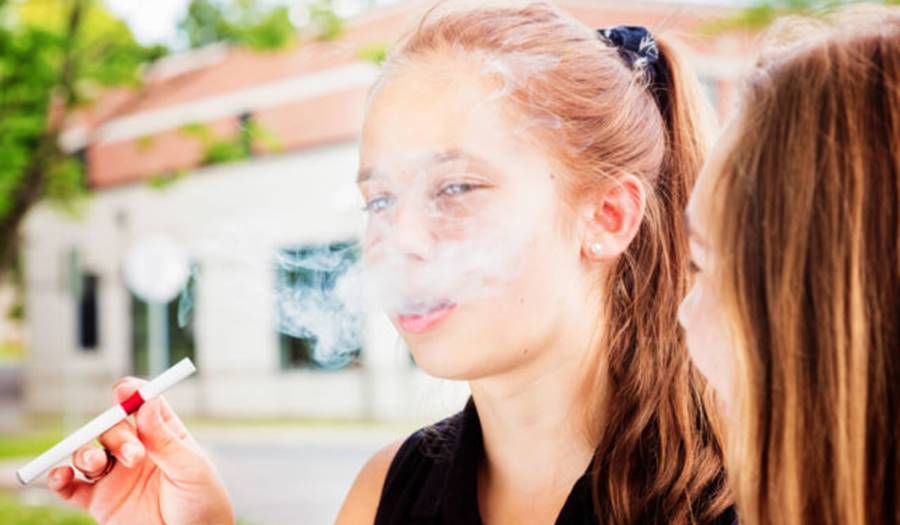
Vaping
4/19/2021
DEVICES
An ENDS system produces an aerosolized mix of nicotine and a flavored liquid that the user inhales. A battery coil in the device heats up the nicotine to produce the vapor. These devices include e-cigarettes, personalized vaporizers, vape-pens, e-cigars, pod systems, and vaping devices. There are many ENDS products available on the market. ENDS devices include:
Rechargeable e-cigarettes with prefilled pods sold by Juul, bo, or myBlue.
Disposable e-cigarettes, produced by Zig zag, Vapor4Life, V2, and White CLoud, often look like traditional cigarettes.
Tank systems can be rechargeable or disposable. Commonly found brands include Aspire, Smok, Vaporesso, and Kangertech.
Vape pens are medium size tank systems. They are compact, easier to conceal, and can be used discretely. This is the most familiar system and includes brands Juul, Aspire, Apollo, and Kangertech.
Often these devices look like common objects (see the sidebar). These devices require a nicotine-based liquid, either sold as e-liquids or e-juices. ENDS are either an open or closed system. In an open system the user has to add an e-liquid. In a closed system the user uses pre-filled cartridges or pods.
WHY IS VAPING INCREASING IN TEENS?
It is increasing in teens because they were directly marketed by the companies selling these products. These companies added flavors to the cartridges to make them more attractive to a young audience. Flavors are the main reason youth site for trying vaping products. The flavors were made to appeal specifically to children and include bubble gum, chocolate, mint, and pina colada. There are thousands of other flavors available.
In a lawsuit started by the Commonwealth of Massachusetts, it was discovered that vaping companies, specifically Juul, targeted teens. They promoted their products on websites frequently visited by children and teens including the Nickelodeon family, including nick.com, nickjr.com, and The Cartoon Networks website. Juul also admitted to working with influencers and celebrities they recruited because these people had a large number of underage followers. They used younger models in their advertising hoping to attract younger users. Juul’s online platform also sold their products to youth and customer service helped teens get around the minimum age sale restrictions. They also offered coupons or deals to make it easy for teens to afford to buy their products, sometimes the price was as low as $1 per pod.
ISN’T IT SAFER THAN SMOKING?
Vaping is NOT safer than smoking and comes with its own unique risks. Vaping solutions contain nicotine and other chemicals that can cause damage to the body. And these are more concentrated than in cigarettes. One pod is the equivalent of 20 cigarettes. Based on surveys of teen suing ENDS products, they report vaping between 1-4 pods a day. Four pods is the equivalent smoking 4 packs of cigarettes a day. The University of California in San Francisco found that Juul pods deliver 5 times more nicotine per puff than a Marlboro cigarette. Vaping devices are also a safety risk. The devices have been known to explode, start fires, and cause burns. Here is how it affects your body:
Lungs:
Vaping, like cigarette smoking, negatively affects lung function. People who vape are more likely to get respiratory infections including influenza and have twice the risk of developing chronic bronchitis. They also are 5 times more likely to test positive for COVID-19. Because vaping causes lung damage and COVID-19 is known to attack the lungs, COVID-19 infeciton is a very serious threat to people who vape and they are at increased risk of severe disease requiring intensive care during their COVID-19 infection.
Vaping also results in severe lung damage, coined EVALI (e-cigarette, or vaping, product use-associated lung injury) that can result in severe respiratory illness. Symptoms include cough, shortness of breath, chest pain, fever, vomiting or nausea. It can be sudden onset or develop over a few weeks. In 2019, there were multiple hospitalizations and deaths due to this illness prompting the CDC to become involved in monitoring the rate of occurrence. While other chemicals cannot be excluded from contributing to the lung damage, the injury to lungs is believed to be caused by Vitamin E oil used in the cartridges. This vitamin is healthy for skin or to be ingested but can cause an oily film in the lungs that results in damage to the airway.

Other Body Systems:
Vaping doesn’t affect only the lungs. It can also cause:
• Nicotine addiction
• Changes to the developing brain affecting memory, attention and learning
• Weakened immune system
• Worsened anxiety
• Erectile dysfunction
• Damaged gums
• Increased risk of heart attack due to damaged blood vessels
• Increased risk of depression (twice as likely to develop)
• Increased risk of using traditional cigarettes or tobacco products
• 2nd hand exposure due to the aerosol in the air
• Increased risk of cancer
The chemicals in the e-liquids or e-juices contain harmful chemicals such as antifreeze and carcinogens. Trace metals such as nickel, silver, arsenic and lead are found in these products. There is 100 times more nickel in a vaping product than in a traditional cigarette. Teens who use vaping products have higher levels of cancer-causing chemicals in their urine.
The pods are also considered poisonous. An amount as small as 2.5 ml (1/2 of a teaspoon) of the e-liquid product can kill a small child. Ingestion can result in increased heart rate, lethargy, seizures, and respiratory distress. The EPA actually consider waste from ENDS products to be hazardous waste that requires special disposal due to the chemicals they contain.
MARIJUANA
Vaping also increases the use of marijuana. The e-liquids or e-juice pods can be tampered with and the drug can be added. Because of the ease of adding marijuana to pods, the use of marijuana among youth has doubled in just the past 2 years!
Of the patients who died of severe lung injury due to vaping, 84% of them had used marijuana (THC) containing products!
AVAILABILITY
It is illegal to sell products to anyone under the age of 18 and in some states, including Massachusetts, 21 years of age. Unfortunately, these requirements are easy to work around and the products are very easy for teens or underage persons to purchase. As we stated before, Juul was not monitoring the ages of the people who purchased their products, and their customer service representatives were actually helping teens get around those restrictions. Other online retailers do not monitor the ages of people purchasing these products, or rely on the honor system, making it easy for teens to have these products mailed to their home, or as we recently learned, to a PO Box they have rented.
Massachusetts has taken a strong stance on vaping products. They limit the sale of flavored products to smoking bars and when we were learning about EVALI, the state stopped all sales of vaping products for a few months. They also have been involved in lawsuits targeting vaping companies for their marketing tactics.
HOW DO I TELL IF MY CHILD IS VAPING?
It can be difficult to tell if your child is vaping as it does not carry the odor of traditional cigarettes. There is not a visible emission or vapor and vape pens can be hidden as common household objects (see side bar). Signs that your child may be vaping include an unexplained sweet scent to their breath or clothing or unfamiliar products in your house. Your child may also be anxious or have trouble concentrating.
Many vaping products are made to look like common household objects. Some vaping pens are disguised to look like Apple watches, a tumbler-style cup, key fobs, inhalers, sharpies or markers, USB ports, phone cases, and can be hidden in hooded sweatshirt strings!

HOW TO TALK TO YOUR TEEN
Talk to your child before they start vaping. Children as young as 3rd grade have heard the term “vaping.” Start the conversation when children are young and have not been exposed. It is much easier to not start an addictive habit than to quit. Here are some tips for what you can do as parents:
• Set an example and do not using tobacco or marijuana
• Start a discussion at a natural time, such as seeing someone vaping in person or on tv or if it is relevant to a discussion
• Discuss the carcinogenic and toxic ingredients used in the e-liquids
• Discuss how nicotine and the toxins can affect their body
• Reiterate that it is NOT safer than smoking cigarettes
• Keep the dialogue open, avoid criticism or harsh judgement
• Avoid lecturing
• Try to have a conversation where your child feels comfortable asking questions and being honest
• Have multiple discussions over year, adjusting it for your child’s age and development
WHAT IF MY CHILD WANTS TO QUIT VAPING?
If your child has started vaping and is interested in quitting, there are many resources available to your family. School systems are recognizing the importance of providing opportunities for students to seek help without worrying about negative consequences at school. School health services can be a great source of locally based information. The Department of Public Health in Massachusetts and New Hampshire have resources for parents and teens. Additionally, there are great online resources including Know the Risks, Smoke Free Teen, My Life My Quit, The Truth and Truth Initiative as well as a hotline you can call: 1-800-QUIT-NOW.
Some children and young adults may need medical help quitting vaping products. Medical assistance includes nicotine patches, nicotine gums, or nicotine lozenges. These are sometimes covered by insurance companies. Because the high dose of nicotine in each pod, with each pod being the equivalent of 20 cigarettes, their addiction may be strong enough to cause severe withdrawal symptoms including
• Irritability
• Restless
• Jittery
• Headaches
• Increased sweating
• Feeling sad or down
• Feeling anxious
• Feeling tired or groggy
• Having trouble concentrating or thinking
• Having trouble sleeping
• Feeling hungry
• Intense cravings for nicotine
Quitting can be very hard. Your child is more likely to be successful if we can limit their withdrawal symptoms and slowly reduce the level of nicotine dependency, especially if they are using more than 1 pod a day.
Vaping is an issue for youth and young adults that quickly became an epidemic. Learning about vaping, vaping products and how teens may try to hide these, and the effects of vaping can help you start the discussion with your child. If you or your child needs to discuss vaping, nicotine products or if your child needs help quitting, please do not hesitate to contact us.
Children’s Health Care of Newburyport, Massachusetts and Haverhill, Massachusetts is a pediatric healthcare practice providing care for families across the North Shore, Merrimack Valley, southern New Hampshire, and the Seacoast regions. The Children’s Health Care team includes pediatricians and pediatric nurse practitioners who provide comprehensive pediatric health care for children, including newborns, toddlers, school aged children, adolescents, and young adults. Our child-centered and family-focused approach covers preventative and urgent care, immunizations, and specialist referrals. Our services include an on-site pediatric nutritionist, special needs care coordinator, and social workers. We also have walk-in appointments available at all of our locations for acute sick visits. Please visit chcmass.com where you will find information about our pediatric doctors, nurse practitioners, as well as our hours and services.
Disclaimer: this health information is for educational purposes only. You, the reader, assume full responsibility for how you choose to use it.








